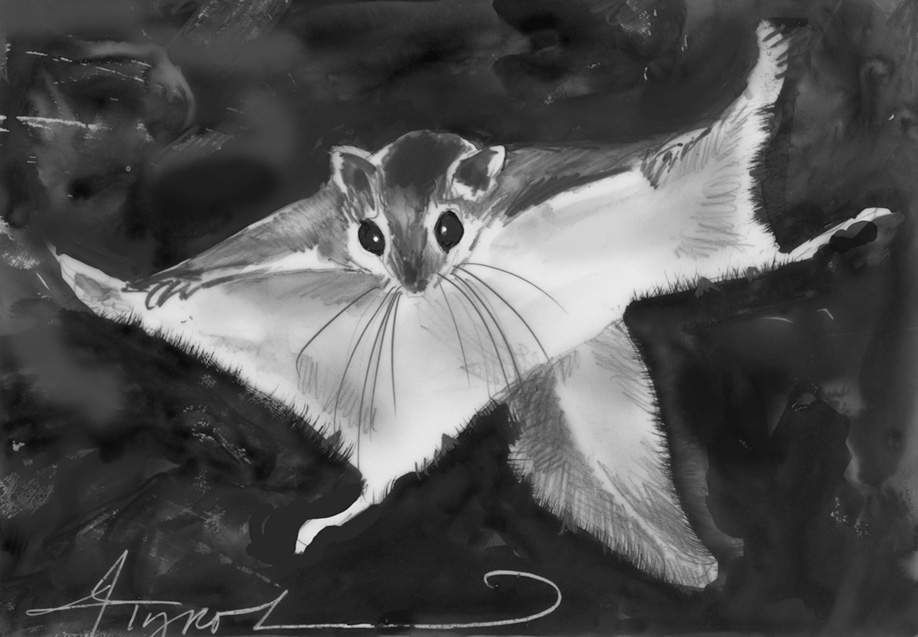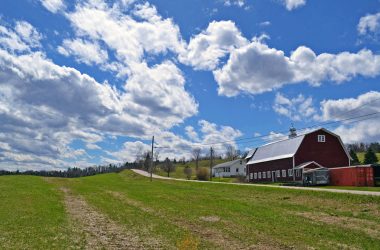
by Gretchen Uhrinek
Pittsburgh, Pa. – It’s evening, and you’re in the forest. You close your eyes and inhale the sharp, sweet, turpentine scent of pine. The air is still, yet the branches overhead seem to nod at your presence. You shine a flashlight and catch a glimpse: a fleeting, tiny ball of fur, arms and legs outstretched, tail like a rudder, gliding through the night. It lands on a tree trunk, pauses, then launches itself again. A flying squirrel, in its glory.
If you’re where winter nights are coldest and pine forests abound, you’re likely in the presence of Glaucomys sabrinus, the northern flying squirrel. In warmer regions or hardwood forests, you might find yourself in the company of their southern brethren, Glaucomys volans. Until recently, the two never crossed paths. Now, they share more than habitat; they’re swapping DNA.
Northern flying squirrels are the larger of the two species. Measuring around 11 inches and weighing about five ounces, slightly less than a baseball, these big-eyed rodents can glide up to 295 feet. They prefer mature coniferous forest and construct nests of lichen and leaves on branches, in tree hollows, and underground. They also build separate latrines, unlike southern flying squirrels, which apparently have no qualm about sleeping in excrement.
Southern flying squirrels average a diminutive nine inches long (tail included), weigh no more than three ounces, and only glide as far as 200 feet. Unlike their northern cousins, these squirrels only nest in tree cavities. Some southern flying squirrel dens will house more than 50 roosting squirrels at a time. Both species are nocturnal and have unique patagia (their “wings”) that help them glide long distances and turn mid-air with great precision.
As northern regions become warmer, southern flying squirrels are appearing in territories which previously only supported their northern cousins. This, paired with deforestation and habitat fragmentation, sometimes forces the two species to share one den. There are two main consequences to this cohabitation: death and life.
Southern flying squirrels often carry Strongyloides robustus nematodes. While this intestinal parasite doesn’t affect southern flying squirrels, it can be fatal to the northern species. Since southern flying squirrels don’t separate their latrines from their nests, and since the nematode spreads through waste, cohabitation is often fatal for northern flying squirrels. In fact, northern flying squirrels are endangered in Pennsylvania, a hotspot of interspecies squirrel mingling.
Now let us consider life. Officially, North America only claims three species of flying squirrels (scientists discovered a third species in the Pacific Northwest in 2017). But now that southern and northern flying squirrels are forced to live in unprecedented closeness (known as “sympatry”), there’s a new squirrel in town. Hybrid flying squirrels, which were first documented in a 2009 study led by researcher Colin Garroway, are not officially a species yet. “What we have here is a ‘leaky’ species barrier,” Garroway said. “In a sense, speciation between northern and southern flying squirrels has not quite finished.”
Garroway and his team first discovered the possibility of hybridization when they started catching “funny-looking squirrels.” Their fur colors and body size weren’t quite right for either northern or southern flying squirrels. Genetic testing confirmed the researchers’ hunch: the two species were interbreeding. Interestingly, their hybrid offspring were also viable breeders, not just with each other, but also with their parental species. This ability to continue reproducing with their parental species is a key reason why speciation has not officially occurred here.
“What’s neat is that [each] species can be maintained, but different genes can cross the species barrier via hybrids,” said Garroway.
As to what this means for the parent species, things could go a few ways. We may see the formation of stable hybrid zones, where the two species consistently interact. We may see improved fitness of the parent species through successful back-crossing of DNA. Or we may witness the extinction of one or both parent species: hybridization-induced extinction, while rare, is not unprecedented. Garroway, however, doesn’t see the latter happening anytime soon.
As climate change shifts habitat boundaries and brings related species into contact with greater frequency, sympatric hybridization is becoming more common. We’re living in a real-time environmental experiment of unprecedented proportions, and nobody is quite sure what will happen next. The world is in a flux of creation and destruction, and flying squirrels are just one part of that. One small, furry, precious part.
[Gretchen Uhrinek is a writer, editor, and biologist living in Pittsburgh, PA. Her work has been published in The Longridge Review, Defenestration Magazine, The Pittsburgh Post-Gazette, and elsewhere. Illustration by Adelaide Murphy Tyrol.]





